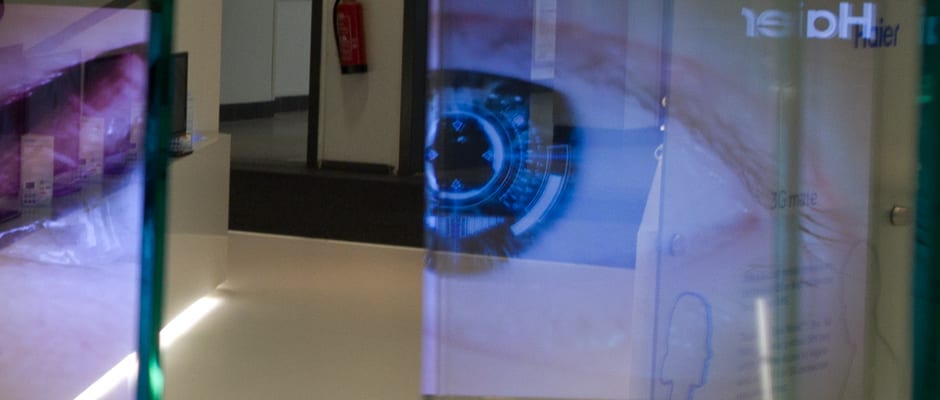The Concept
The future is now.
Technically the Eye-Control is not an actual TV, but rather a software application that allows the use of the Tobii eye motion sensor. Tobii has been working to bring accurate eye-motion control into homes and business for a few years now, and the Eye-Control is a step in the right direction. We first tried the Tobii Gaze at CES 2012, using a PC running Windows 8.
The Tobii system houses three main components: near-infrared microprocessors, optical sensors, and image processors. The microprocessors project minute reflective images onto the eye, while the optical sensors register the images in relation to the user's retina and face positions. Finally, the image processors interpret this data in order to determine exactly what portion of the screen the user is focusing on. While this sounds pretty simple, there is a great deal going on under the hood that the user will be unaware of.
{{ gallery "Tobii",}}
Design
Eye-candy
It's difficult (not to mention slightly meta) to judge the Eye-Control's appearance. The system is still in the concept phase of development, so what we see on the show floor is unlikely to resemble the finished product when (and if) it launches. The Tobii device has slimmed down since its last appearance at IFA, and would fit comfortably in any living room in its current form. Haier is still undecided on exactly where to place the final product, but most likely the system will be housed in the TV itself.
When viewed alongside the sleek Tobii device, Haier's user interface looks positively archaic. On screen, the available options are large and blocky—no doubt in order to make them easy to select with the cursor.
{{ gallery "Usability",}}
Usability
It's a bit of an eye-sore, to be honest.
Before discussing our experience trying out the Eye-Contact, we should be clear that the device is still conceptual and usability bugs are to be expected. That being said, we had an almost comically difficult time getting the Eye-Contact to work as intended. First off, there are certain stringent calibration requirements involved in using the device. The user cannot be more than about 5 or 6 feet away (1.5–2m) from the TV. Additionally, the Tobii cannot adjust for head movement, so any lateral or vertical head movement should be avoided. It's similar to how you would imagine a portrait session from the early days of photography, whereby the subjects would be required to sit still for up to 15 minutes.
Theoretically, when using the Eye-Contact, a crosshair will follow the focus of the user's gaze: scan the screen from left to right, and the crosshair will follow. The upper and lower portions of the screen reveal volume and channel icons when the crosshair cycles over them. Blinking performs the function of a button press. The device is designed to function regardless of whether or not the user is wearing glasses. To be safe, we used the Eye-Contact with, and without, glasses. In both cases the result was the same.
So how easy was the Eye-Contact to use? How about... not at all. Despite my best efforts, I was unable to control the on-screen crosshair with any accuracy. The crosshair would lazily follow my gaze, while occasionally taking lengthy dalliances to random portions of the screen. After some uncomfortable eye exercise I was able to highlight the Decrease Volume icon. I tried blinking, nothing happened. I blinked again, same result. What's more, with each blink the crosshair strayed from its original placement, forcing me to readjust my gaze. After only a few minutes of this my eyes began to hurt.
With some trial and error, I was finally able to access the channel menu and cycle between the pre-set selection of clips, but this was largely thanks to the larger surface area of the channel icons.
{{brightcove '2654983548001'}}
Beyond the Concept Phase
So who exactly is this for?
The knee-jerk reaction to innovations like the Eye-Contact is often one of disdain. Cynics assume that the Eye-Contact is the coach potato's killer app. However, the practical applications for the Eye-Contact go beyond the living room. For example, the device—once perfected—would be helpful for quadriplegics and others that can't use a common remote control. Haier is also in talks with a number of medical facilities regarding the Eye-Contact. Whether optimized for those in need, honed for general hands-free operation, or the joy of the lazy, we imagine that eye-controlled TVs could certainly find a home. {{vine 'hJprg9a2WhT'}}
Final Thoughts
Don't throw out your remote just yet.
Ultimatly, we left disappointed with our Eye-Contact experience. The system has potential, but is far from consumer ready. Considering that the primary selling point of the Eye-Contact—the user interface—is so fatally flawed, we can't imagine that we will see a commercial model available anytime soon. For the forceable future it would appear that remote, voice, and gesture controls are here to stay.
Meet the tester
Aside from covering all things sleep, James moonlights as an educational theatre practitioner, amateur home chef, and weekend hiker.
Checking our work.
Our team is here for one purpose: to help you buy the best stuff and love what you own. Our writers, editors, and lab technicians obsess over the products we cover to make sure you're confident and satisfied. Have a different opinion about something we recommend? Email us and we'll compare notes.
Shoot us an email


